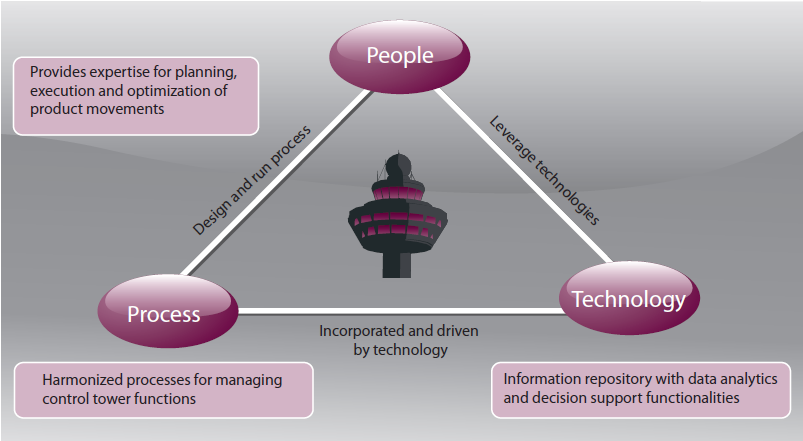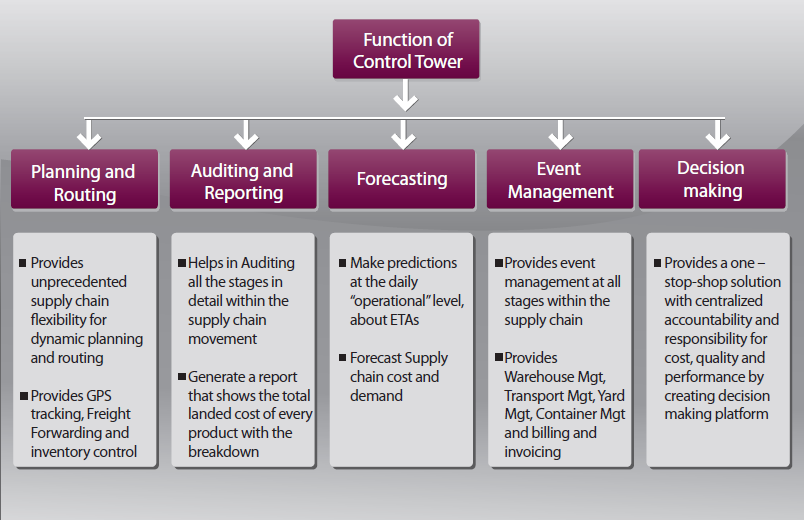People are always coming up with new terms to sell their products or services. However, when one starts hearing the same term from different quarters, it’s generally time to start paying closer attention. Supply chain “control tower” is one of those terms. James A. Cooke, Editor of CSCMP’s Supply Chain Quarterly, believes that control towers could be the next big thing in supply chain management. [“The next big things: ‘control towers’ and demand shaping,” 20 June 2011] Cooke writes:
“In the supply chain sense, a control tower is a location that provides visibility into inbound and outbound distribution flows—much as a control tower coordinates the movement of aircraft to and from an airport.”
You hear the term “visibility” as well as the term “transparency” in most supply chain management discussions nowadays. If Cooke and other analysts are correct, you will soon be hearing the term “control tower” just as often. Cooke indicates that one global company that successfully uses control towers is Procter & Gamble. He reports that P&G “has set up ‘control towers’ to help it manage its distribution networks in emerging markets in Eastern Europe, the Middle East, and Africa.” He continues:
“Although a number of companies in Europe have adopted the control tower concept, P&G’s case is particularly interesting because executives believe that this approach will help the consumer goods giant control distribution costs and manage supply flows into emerging markets.”
After reading Cooke’s short piece, supply chain analyst Trevor Miles wrote, “It is amazing how there can be a synergy that drives several parties to coalesce around the same idea. … Well somehow the notion of a supply chain control tower has gained broad interest lately across a broad spectrum of industries.” [“The Next Big Thing: ‘Control Towers’,” The 21st Century Supply Chain, 5 July 2011] He continues:
“From my perspective, the application of the control tower concept only to distribution is a fairly narrow use of a very powerful concept. A multi-tier control tower in the high-tech/electronics space that spans customer location, the OEM, several contract manufacturers, and component suppliers has much greater likelihood of both success and benefit. Time and time again I hear about visibility being a problem in this environment. What better way to get visibility than to have a single system that sucks in data from multiple systems of record (not just ERP) to provide this visibility? But visibility is not enough. Don’t get me wrong, knowing about an issue is hugely better than not knowing about an issue until only after you feel the impact. But even better than knowing about an issue is knowing about the consequences of that issue. Will it affect customers service? Will more material be required? Will we need an extra shift? Will we miss the quarter? Without this type of consequence analysis, knowing of the issue itself is relatively uninteresting and of little value (beyond the people directly affected that is.)”
As usual, Miles makes a great point. Knowledge is only valuable if it can be acted upon. Air controllers need to know the speed, direction, and altitude of aircraft so that they can keep them safe. They know the disastrous consequences of two aircraft trying to share the same airspace at the same time. Along those same lines, Miles is insisting that companies need to know enough about their supply chains that they can avert disastrous consequences. He discusses the importance of “what if” analysis — something I discuss more fully in a post entitled Modeling “What If” Scenarios. Miles writes:
“Even better, is to be able to perform ‘what-if’ analysis to determine the best course of action to avoid the risks and negative consequences of events. But in a multi-tier, and therefore multi-organization, supply chain there is no obvious ‘best way’ to resolve the issue in the best interests of all the participants. There is a natural tension between the objectives of the different tiers that has to be negotiated. However, in a multi-tier supply chain, how do you determine who is impacted and who needs to take action? After all, without this knowledge how is resolution possible?”
Miles points out that control towers are designed to answer those kinds of questions — at least control towers designed to go “beyond simple visibility.” He writes, “Visibility is a start, consequence evaluation the next step, ‘what-if’ analysis leading to resolution is the third step, and multi-enterprise collaboration the final stage and most complete description of a control tower.” Miles’ big concern is that control towers require collaboration and collaboration requires trust. He is not sure that trust between supply chain stakeholders is getting any better despite everyone’s belief that collaboration will be an important differentiator in the decades ahead. Although the notion of control towers takes on new significance as a result of emerging technologies, Miles asserts:
“We have been talking about control tower like concepts for 50 years ever since Jay Forrester published his work in industrial dynamics – ‘Industrial Dynamics-A Major Breakthrough for Decision Makers,’ in: Harvard Business Review, 1958, Vol. 36, No. 4, pp. 37–66 – and the bull whip effect in which he states that:
Company (and supply chain) will come to be recognized not as a collection of separate functions but as a system in which the flows of information, materials, manpower, capital equipment, and money setup forces that determine the basic tendencies towards growth, fluctuation, and decline.
“… We need to get from ‘this is what is happening’ to ‘who needs to know.’ … I think we have some way to go before this all gels into something really significant, but it is very exciting to be part of the process, to see customers and prospects exploring control towers and making the first steps to meaningful adoption, well beyond simple visibility.”
One comprehensive overview of control towers can be found in a position paper written by Capgemini analysts Gaurav Bhosle, Prashant Kumar, Belinda Griffin-Cryan, Rob van Doesburg, MarieAnne Sparks, and Adrian Paton entitled Global Supply Chain Control Tower. You can register to download a copy of the paper. In the introduction to the paper, the authors write:
“Supply Chain Visibility is the key enabler for managing a business both within the organizational boundaries as well as across the boundaries. This visibility provides speed, reliability and flexibility in order to gain a competitive advantage in the form of well controlled and managed supply chain functions. In response to the need for Supply Chain Visibility, the leading Supply Chain Visibility principles are increasingly being embodied in Supply Chain Control Towers. A supply chain control tower is a central hub with the required technology, organization and processes to capture and use supply chain data to provide enhanced visibility for short and long term decision making that is aligned with strategic objectives.”
The authors claim that good control towers rest on three pillars, people, processes, and technology (as depicted in the graphic below).

There is certainly nothing new about those pillars. They are the same pillars that undergird most successful business activities. For example, Karin L. Bursa, Vice President of Marketing at Logility, insists that a successful S&OP system will take into account “people, process, and technology” [“A Foundation for Successful S&OP,” Supply Chain Digest, 10 February 2011]. She writes:
“This trio of people, process and technology, is the foundation for success. This foundation will provide needed structure along with the flexibility to evaluate and respond to a variety of business challenges and opportunities.”
Perhaps the most important thing that a control tower can do is breach barriers created by organizational silos. The Capgemini analysts write:
“Control Towers are cross-divisional organizations with system integrated ‘information hubs’ that provide Supply Chain Visibility. These hubs are used for gathering and distributing information, and allow people trained to use these visibility capabilities to detect and act on risks or opportunities more quickly. Control Towers are typically set-up to monitor, measure and manage transport and inventory movements across the supply chain.”
They identify five functions that can benefit from the creation of a control tower. They are: planning & routing; auditing & reporting; forecasting; event management; and decision making.

The report goes on to describe a number of benefits that are obtained from implementing a control tower. The benefits are detailed in four broad areas: general supply chain operations, outbound activities, manufacturing, and inbound operations. Those benefits include:
General Operations
• Integrated Supply Chain with an ability to retrieve information
• Reduced compliance Penalties
• Improve decision-making capabilities
• Reduced network failures, increased network visibility and responsiveness
• Respect customer commitment: schedule, costs, quality and Improved customer satisfactionInbound Operations
• Optimal inventory levels and reduced buffer inventory
• Synergies in procurement transport carriers leading to reduction in Transportation Expense
• Reduction in total landed costs & increase On Time & In Full deliveries
• Helps to change sourcing strategies, shift supplier allocations, modify commercial terms, re-engineer a logistics process or swap out a logistics partnerManufacturing
• Awareness of [work in progress] & improved productivity
• Manufacturing in optimal way over plants operating globally
• More accurate demand planning, better scheduling, reduction in cycle times, reduced inventory levels and timely and complete management informationOutbound Operations
• Improved load efficiency in Outbound
• Improve transport efficiency using best-in-class carriers and redesigning transport solutions
• Ability to predict right ETA for customers
The study concludes with some recommendations about how to set up a control tower and a case study about how Samsung improved its operations after establishing one. Since Enterra Solutions® creates the kind of technological solutions well-suited for use in supply chain control towers, this is a topic I will be watching with keen interest.




